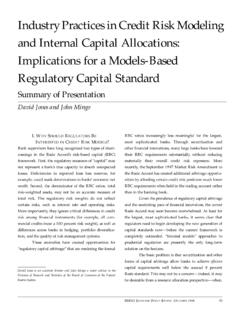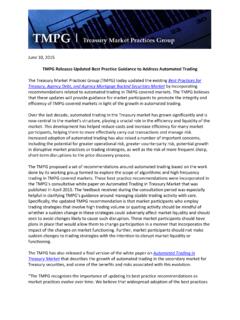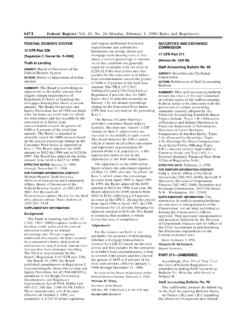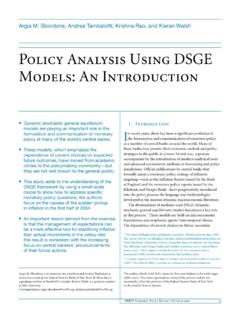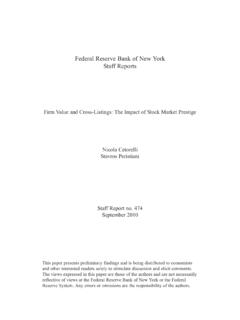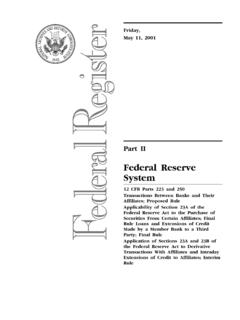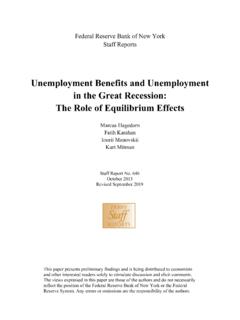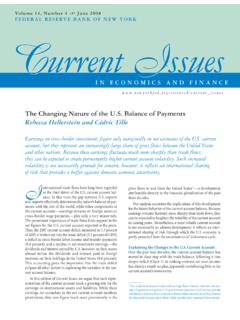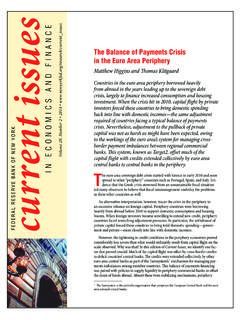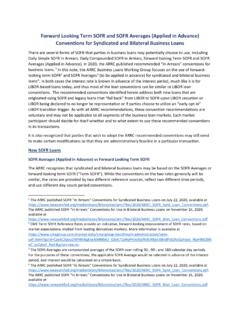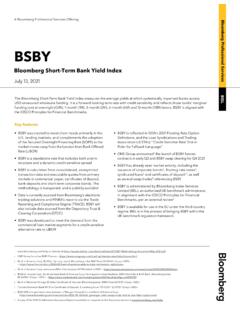Transcription of How to Use SOFR - Federal Reserve Bank of New York
1 David BowmanSenior Advisor to the BoardThis information is provided for illustrative and educational purposes only. The views expressed in this presentation are solely those of the author and do not necessarily represent those of the Federal Reserve , the Alternative Reference Rates Committee or its members or ex officio to Use sofr -2-101234567200020022004200620082010 2012201420162018 Overnight RFRsSOFR/Historical Repo RateTONAEONIASONIASARONP ercent-2-1012345672000200220042006200820 1020122014201620183-Month Averages of Overnight RFRsSOFR/Historical Repo RateTONAEONIASONIASARONP ercentAveragingThe financial contracts using overnight RFRs have referenced an average (1-month or 3-month) of the overnight RFR for floating rate payments, not one-day s value.
2 Those averages tend to be very smooth and appropriate for use in financial contracts (a 3-month average of sofr is less volatile than 3-month libor , even over year ends).Source: BloombergSource: BloombergCompound versus Simple AveragingCompounding interest reflects the time value of money for example, a money market account pays compound interest and is used in OIS swaps and some futures. However, other contracts use simple averaging, largely because of historical precedent. There is some basis between the two types of averaging, but it is generally small and any difference can be adjusted for so that borrowers do not pay more or less under either 2: Basis between Compound and Simple Interest (bp)Loan Rate:1 percent5 percent10 percentLoan Basis Between Compound and Simple sofr (bp)MonthlyQuarterlySemiannualSource: Federal Reserve bank of New york , staff estimatesModels for Using RFRsThe FSB and National Working Groups are looking at several models for using overnight risk-free rates in cash products In ArrearsoPlain: Used averaged rate over current interest period, paid on last day of the period (day T)oPayment Delay.
3 Use averaged rate over current interest period, paid kdays after day T (Note: ISDA s conventions for sofr swaps use a 1-day payment delay)oLookback: Use averaged rate over current interest period lagged kdays (a 3-5 day lookback has been used in SONIA FRNs)oLockout: Use averaged rate over current period with last krates set at the rate for day T-k (a 3-5 day lockout has been used in most sofr FRNs). In AdvanceoLast Reset: Use averaged RFR from the last interest reset period as rate for current reset periodoLast Recent: Use averaged RFR from a shorter recent period as rate for current reset period Hybrid ModelsoPrincipal Accrual: Payments set In Advance, principal and interest accrue In ArrearsoInterest Rollover: Payments set In Advance, any missed interest relative to In Arrears is rolled over into the next payment ArrearsUse RFR forDay 1 Use RFR forDay RFR forDay T-3 Use RFR forDay T-2 Use RFR forDay T-1 Use RFR forDay TPayment Due(Note.)
4 Technically, Plain Arrears is not Possible if the RFR is Published with a 1-Day Lag)Use RFR forDay 1 Use RFR forDay RFR forDay T-3 Use RFR forDay T-2 Use RFR forDay T-1 Use RFR forDay TPayment DueUse RFR forDay 1 Use RFR forDay RFR forDay T-3 Use RFR forDay T-2 Use RFR forDay T-2 Use RFR forDay T-2 Payment DueUse RFR forDay -1 Use RFR forDay RFR forDay T-5 Use RFR forDay T-4 Use RFR forDay T-3 Use RFR forDay T-2 Payment DueDay 0(Last Day of Previous Period)Day 1(First Day of Interest Period)Day T-3 Day T-2 Day T-1 Day T(Last Day of Interest Period)Day T+1(First Day of Next Period)Day T+2 RFR for Day 1 PublishedRFR for Day T-4 PublishedRFR for Day T-3 PublishedRFR for Day T-2 PublishedRFR for Day T-1 PublishedRFR for Date T PublishedTable 3: Models for Using RFRs in ArrearsArrears with 2-Day Payment Lag (Generally Used in OIS)Arrears with 2-Day LockoutArrears with 2-Day LookbackPros and ConsPayment Delays or Lookbacks are consistent with ISDA compounding definitions and more easily hedged and do not skip any interest days.
5 A lockout does skip some days and has some basis to the In Arrears model used in OIS swaps (below), On the other hand, for most of the interest period, the daily interest rate will correspond to the most recent published value of the RFR, which may be important to certain investors who do not have hedging between Quarterly Compounded 3-day Lockout vs Pure Arrears (bp)Source: Federal Reserve bank of New york , staff estimatesIn Advance versus In ArrearsThe tension between In Arrears and In Advance is that borrowers will reasonably prefer to know their payments ahead of time well ahead of time for a consumer product and so prefer In Advance, while investors will reasonably prefer returns based on rates over the interest period (In Arrears) and view rates set In Advance as out of date.
6 But this isn t an entirely new problem: One-Year libor (which is used in most adjustable rate mortgages currently) can often quickly become out of date, by about the same magnitude that a compound overnight rate (here EFFR) has become out of date, so while these issues will rightly be an area of focus, this is already an issue in the current market although it doesnot receive much focus. 0246810121985198819911994199720002003200 62009201220152018 Historical Gaps Between libor and libor ARM Resets1-Year USD LIBORM onthly Rate on a 1-Year libor ARM with resets at thestart of each yearPercent-6-4-202461984198619881990199 2199419961998200020022004200620082010201 2201420162018 Comparing Changes in 1-Year libor to the Difference between Compound EFFR in Advance and In ArrearsAnnual Change in 1-Year LIBORD ifference between 1-Year Compound EFFR In Arrears and In AdvancePercentSource: Federal Reserve bank of New york , staff estimatesSource.
7 Federal Reserve bank of New york , staff estimatesIn Arrears/In Advance (continued)The amount of basis between In Advance and In Arrears also depends on the frequency of interest periods. With a one-month reset, the basis is comparable to the amount of basis between simple and compound averaging. Even at 3-or 6-month resets the basis is limited and averages out to zero over longer periods of time. The below graph shows what would have been the historical basis on a hypothetical 5-year loan based on EFFR in Advance relative to a loan based on EFFR in arrears for 1-month, 3-month, and 6-month interest periods. -60-50-40-30-20-100102030401990199219941 99619982000200220042006200820102012 Basis Spread between in Advance and In Arrears 5-Year Loan with Monthly Payments (bp)1 MonthSpread3 MonthSpread6 MonthSpreadSource: Federal Reserve bank of New york , staff estimatesModels of In AdvanceUsing Last Reset with a shorter reset period and/or Using Last Recent can substantially cut the basis to relative to In Arrears.
8 Below we show what the historical basis would have been on a hypothetical 5/1 ARM based on EFFR in Advance relative to EFFR in Arrears using different reset periods and different variations of Last Recent / Last Reset -60-40-200204060198319851987198919911993 19951997199920012003200520072009 Comparing Bases to In Arrears for Different Models of In Advance MortgagesOne Year Reset, Last Three Months AdvanceOne Year Reset, Last Year AdvanceOne Month Reset, Last Month AdvanceThree Month Reset, Last Three Months AdvanceSix Month Reset, Last Six Months AdvanceSix Month Reset, Last Three Months AdvanceSix Month Reset, Last Month AdvanceBasisPointsSource: Federal Reserve bank of New york , staff estimatesSizing the Amount of Basis RiskBy way of a comparison, the amount of basis risk in a Last Reset 6-month sofr In Advance Mortgage would historically have been clearly smaller than the amount of risk involved in a mortgage being prepaid one year earlier or later than expected.
9 And the basis risk involved should be easier to hedge and is only ever relevant for hybrid ARMs that move in to the variable rate more than half close out before a variable rate applies. 0%2%4%6%8%10%12%14%16%18% Basis Risks Basis Risk of Last Reset 6 Month sofr in AdvanceBasis Risk of 1 Year Earlier/Later PrepaymentSource: Federal Reserve bank of New york , staff estimatesHybrid ModelsHybrid models would be new but eliminate almost all basis relative to in Arrears and in a loan or mortgage while allowing the borrower to know their payments in Advance. If used in a consumer ARM, they would not materially alter the cumulated mortgage payments that a consumer would make or the principal they would pay down, for example, relative to a basic Last Reset 6 Month In Advance Mortgage.
10 However, they would be a new form of product and would need to be explained in a way that consumers felt comfortable with, and servicers would need to be able to support these models. 40%50%60%70%80%90%100%110%19831986198919 92199519982001200420072010 Cumulated Mortgage PaymentsLast Reset 6 MPrincipal AccrualInterest RolloverPercent of LoanAmount2%4%6%8%10%12%14%16%18%1983198 619891992199519982001200420072010 Principal Paid DownLast Reset 6 MPrincipal AccrualInterest RolloverPercent of Loan AmountSource: Federal Reserve bank of New york , staff estimatesSource: Federal Reserve bank of New york , staff estimates

